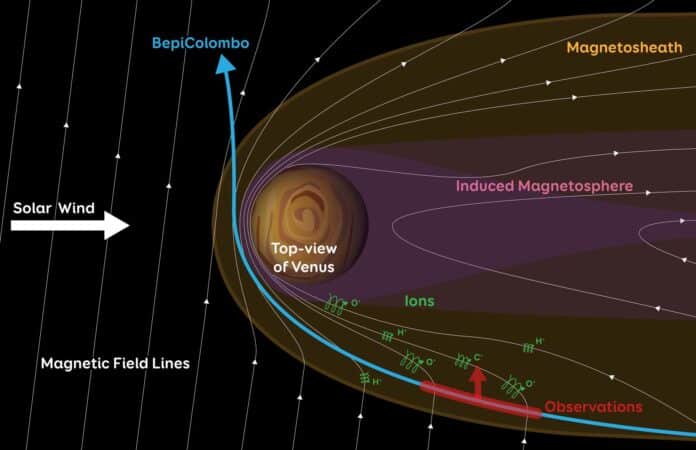Venus’s core does not produce an inherent magnetic field like Earth’s. However, the interaction of electrically charged particles in Venus’s upper atmosphere with charged particles released by the Sun (the solar wind) creates a faint, comet-shaped “induced magnetosphere” surrounding the planet. The “magnetosheath,” an area encircling the magnetosphere, is where the solar wind is heated and slowed down.
BepiColombo passed Venus on August 10, 2021, to slow and adjust its trajectory to reach Mercury, its ultimate destination. The spacecraft passed through the magnetic areas closest to the Sun through the nose of Venus’s lengthy magnetosheath. Over a ninety-minute observation session, BepiColombo’s instruments monitored the quantity and mass of charged particles it encountered. This allowed for data collection regarding the physical and chemical processes responsible for atmospheric escape in the magnetosheath’s flank.
The ESA/JAXA BepiColombo mission’s brief visit to Venus has provided new information about how gases are removed from the planet’s upper atmosphere.
Carbon and oxygen are being accelerated to rates at which they can escape Venus’s gravitational pull, according to discoveries made in a hitherto uncharted area of the planet’s magnetic environment.
Lina Hadid, CNRS researcher at the Plasma Physics Laboratory (LPP) and lead author of the study, said: “This is the first time that positively charged carbon ions have been observed escaping from Venus’s atmosphere. These heavy ions are usually slow-moving, so we are still trying to understand the mechanisms at play. It may be that an electrostatic ‘wind’ is lifting them away from the planet, or they could be accelerated through centrifugal processes.”
Numerous missions, such as NASA’s Pioneer Venus Orbiter and ESA’s Venus Express, have conducted in-depth analyses of the kind and amount of molecules and charged particles lost into space. However, the expeditions’ orbital routes left many questions needing to be solved and certain parts of Venus unexplored.
During the spacecraft’s second flyby of Venus, data were collected for the study using the Mercury Ion Analyzer (MIA) and the Mass Spectrum Analyzer (MSA) on BepiColombo. Mio, the Mercury Magnetospheric Orbiter led by JAXA, carries two sensors as part of its instrument suite for the Mercury Plasma Particle Experiment (MPPE).
Dominique Delcourt, researcher at LPP and the Principal Investigator of the MSA instrument, said, “Characterising the loss of heavy ions and understanding the escape mechanisms at Venus is crucial to understand how the planet’s atmosphere has evolved and how it has lost all its water.”
Europlanet’s SPIDER space weather modeling tools enabled the researchers to track how the particles propagated through the Venusian magnetosheath.
“This result shows the unique results that can come out of measurements made during planetary flybys, where the spacecraft may move through regions generally unreachable by orbiting spacecraft,” said Nicolas André of the Institut de Recherche en Astrophysique et Planétologie (IRAP) and lead of the SPIDER service.
Journal Reference:
- Hadid et al. BepiColombo observations of oxygen and carbon ions in the flank of Venus induced magnetosphere. Nature Astronomy, 12 April 2024. DOI: 10.1038/s41550-024-02247-2
